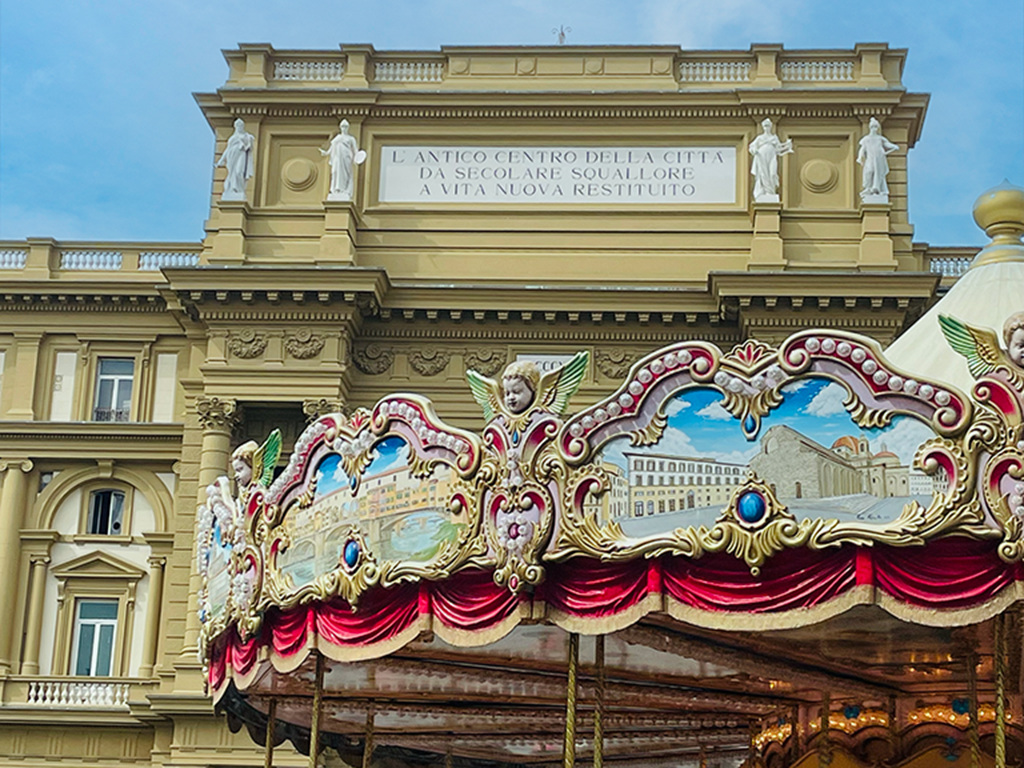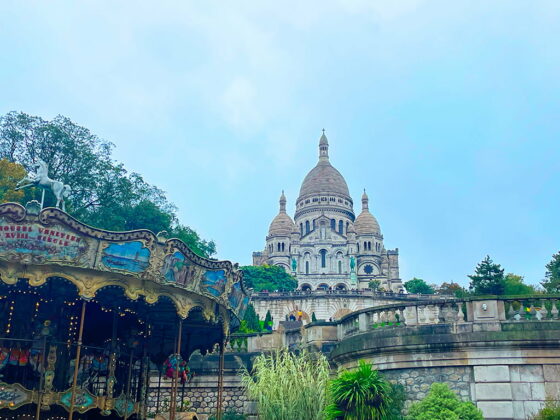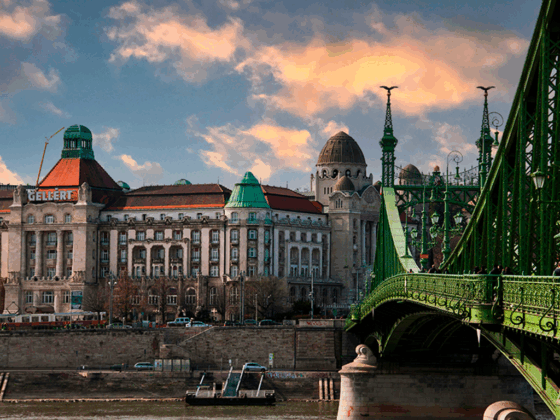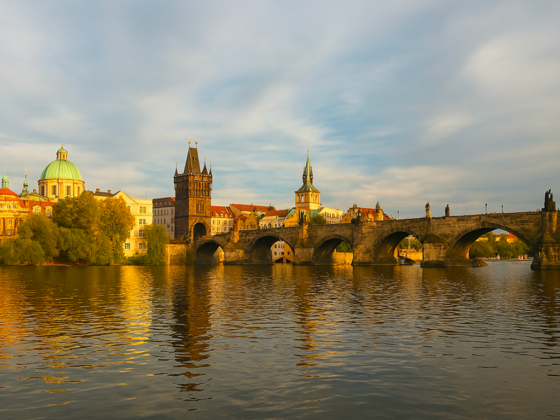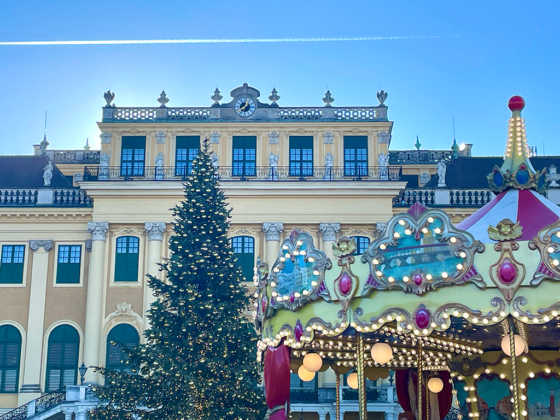Florence is one of Italy’s most fascinating and culturally rich cities, where history and art blend perfectly to create a timeless masterpiece that has inspired poets, artists and dreamers for centuries. The capital of Italy between 1865 and 1871, it is also known as the ‘cradle of the Renaissance’ because it was here that the artistic movement took its first steps, thanks to great masters such as Brunelleschi, Donatello, Masaccio and Michelangelo.
Florence is certainly a city that offers much more than can be seen in a single day, but this walking itinerary will lead you to discover the artistic and architectural treasures of classical Florence, allowing you to immerse yourself in its thousand-year history while discovering some of its main attractions.
However, if you have more days to spend visiting it, you can add stops at the most famous museums and the city’s most beautiful panorama!
Map
One-day walkingitinerary
The itinerary starts from the Santa Maria Novella station, the arrival point for many who travel by train but also convenient for those arriving by car. There are in fact numerous car parks around the station. In addition, the station is very close to all points of interest and the city centre.
Start the day early as you only have one day at your disposal. The centre of Florence is quite small and you can get around very well on foot, but try not to leave later than 8.30am, by which time many of the interesting places are already open.
Basilica of Santa Maria Novella
The name Santa Maria Novella derives from the fact that the church was built on the site of a pre-existing Marian church, but its current structure dates back to the 13th century. The exterior of the basilica is a perfect example of Florentine Gothic, with its white and green marble façade adorned with a series of frescoes and floral decorations. This façade is a true work of art in itself and represents the architectural elegance of the period.
However, the real beauty of the Basilica di Santa Maria Novella is found inside: an extraordinary display of Renaissance works of art and decoration. The basilica houses masterpieces by artists such as Giotto, Masaccio, Filippo Lippi and Domenico Ghirlandaio. Among the most famous works is Masaccio’s fresco cycle in the Brancacci Chapel, considered one of the high points of Renaissance art. The basilica is also famous for the Old Sacristy and the New Sacristy, fascinating examples of Renaissance architecture, which contain numerous tomb monuments of important Florentine historical figures. Not to be missed is the Green Cloister, with its central lawn surrounded by Gothic arches and columns, a peaceful and evocative place.

Republic Square
Piazza della Repubblica, is one of the liveliest squares in the city, a place that blends historical atmosphere with contemporary vitality in a fascinating combination.
The square is surrounded by historical buildings that reflect Florentine Renaissance architecture. One of the distinctive features of Piazza della Repubblica is theArcone, a large triumphal arch built to commemorate the entry of King Victor Emmanuel II into Florence in 1865, celebrating the Italian Risorgimento and the unity of the country. Among the best known buildings is the famous Caffè Gilli, an iconic café that has been a meeting point for intellectuals, artists and travellers for over a century. It is the ideal place to enjoy a traditional Italian coffee or treat yourself to one of the café’s sweet delicacies. The square is also overlooked by theSavoy Hotel, the Central Post Office and the Hard Rock Cafe.
The square is also the ideal place to immerse yourself in the artistic atmosphere of Florence. Street artists and musicians offer performances that add a touch of magic and joy to the area. You can find picturesque stalls selling souvenirs, books and local art objects, offering the opportunity to take home a special souvenir of your visit. One of the most striking attractions in the square is the large merry-go-round, a reminder of the Florentine tradition. This merry-go-round is a charming addition to the square and lends a touch of magic to the ambience.
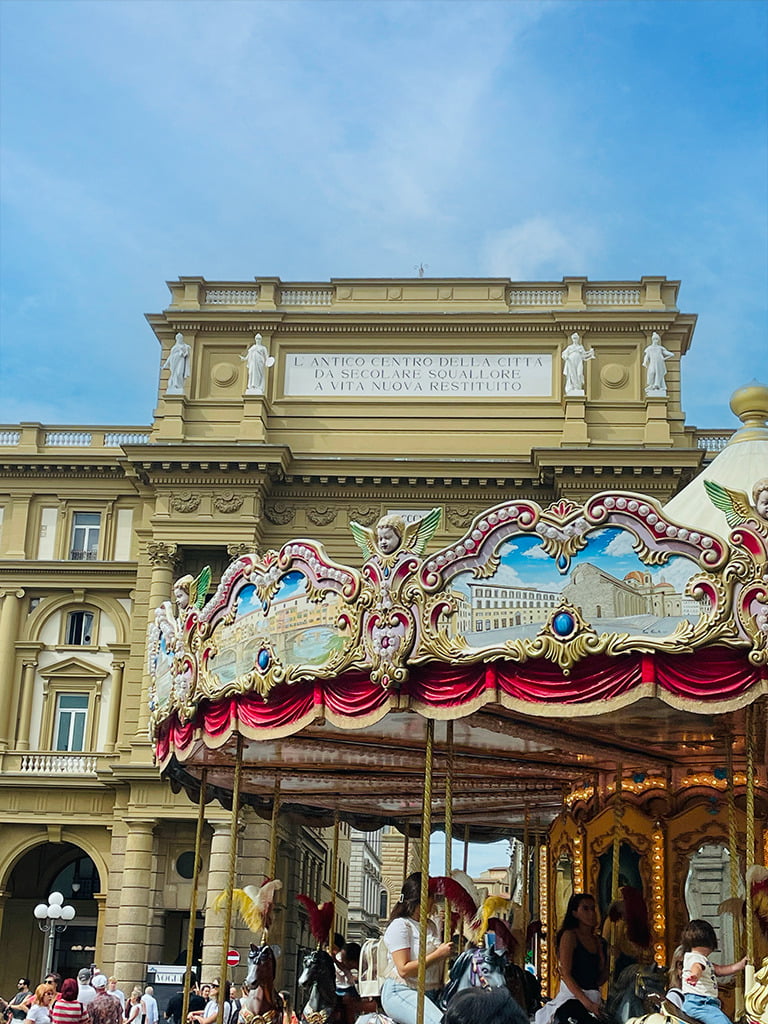
Cathedral of Santa Maria del Fiore
The Cathedral of Santa Maria del Fiore is one of Italy’s most iconic architectural masterpieces and a major tourist attraction in Florence. This majestic sacred building is a testament to the artistic and spiritual grandeur of the Italian Renaissance, a symbol of Florence and a place that enchants visitors from all over the world.
When approaching the Cathedral, the first thing that catches the eye is its extraordinary white, pink and green marble façade, decorated with intricate Renaissance reliefs and sculptures. The interior of the Cathedral is equally impressive, with large light-filled spaces, imposing columns and beautiful frescoes, including the Last Judgement painted by Vasari and Zuccari.
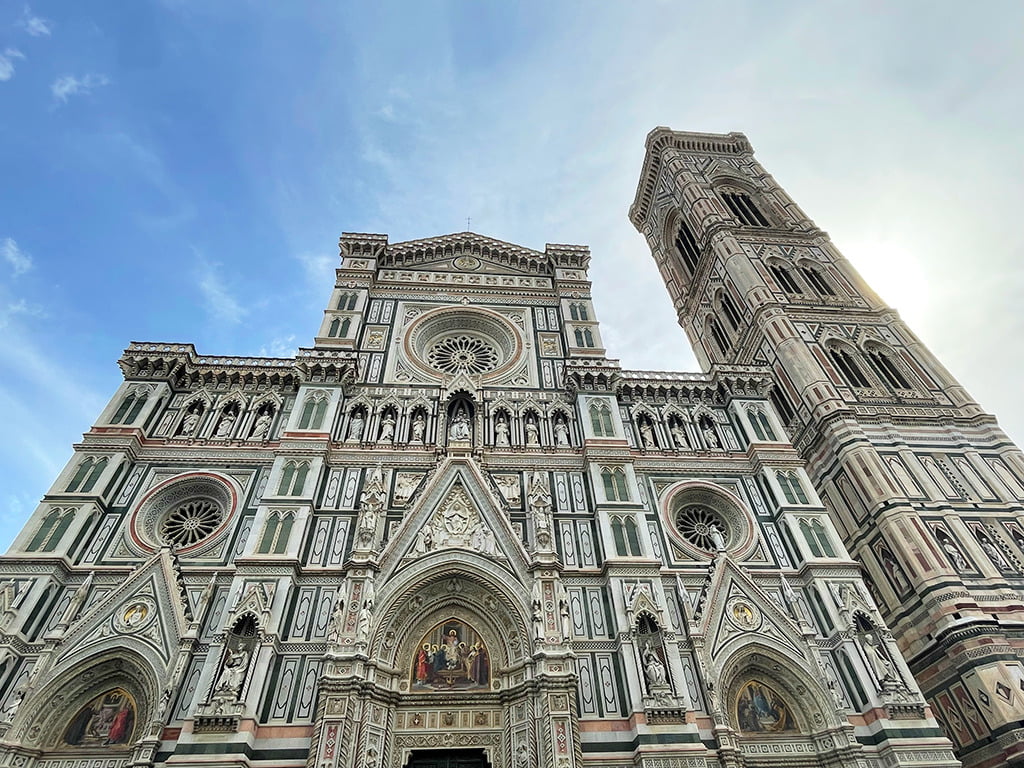
TipsforTrips: You can visit the church for free, while you need to buy tickets to access Giotto’s Bell Tower, the Baptistery of San Giovanni and Brunelleschi’s dome. The Piazza del Duomo is a place where careful planning is required: to climb to the top of the dome, you need to book your ticket several days in advance.
Brunelleschi’s Dome
Brunelleschi’s Dome is an extraordinary architectural masterpiece. Built between the 14th and 15th centuries, this dome, an integral part of the Cathedral of Santa Maria del Fiore, is one of the city’s most iconic symbols.
Designed by the skilled architect Filippo Brunelleschi, the Dome represents a triumph of engineering and art. Its construction without the use of external scaffolding, a daring feat for the time, is an extraordinary example of creativity and innovation.
Climbing the 463 steps to the top of the dome is a fascinating experience. Once at the top, you will be rewarded with a breathtaking panoramic view of Florence and the surrounding Tuscan hills. It is a unique opportunity to admire the city from an extraordinary perspective and to understand Brunelleschi’s ingenuity and mastery.
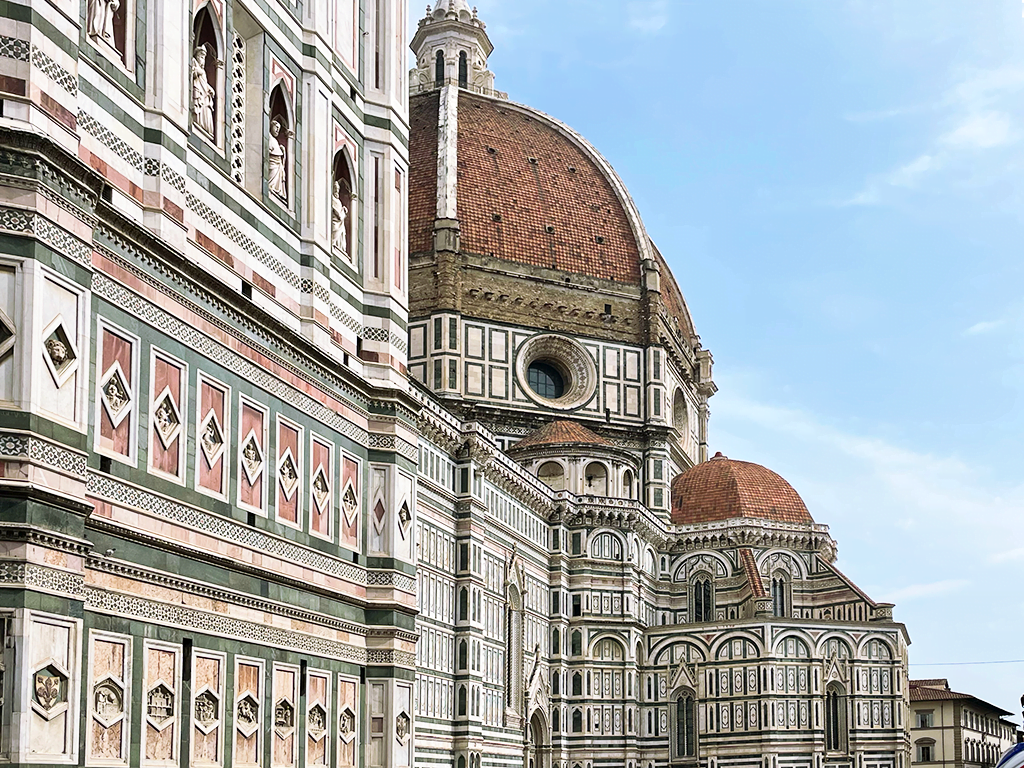
Baptistery of St John
The Baptistery of San Giovanni, located opposite the Cathedral of Santa Maria del Fiore, is a sacred building, a masterpiece of architecture and symbolism, dating back over a thousand years.
The exterior of the Baptistery is impressive, with its dark green and white marble façade embellished with Gothic statues and decorations. Of the three gates to the Baptistery, the most important is the ‘Gate of Paradise‘, located on the main façade in front of the Cathedral. Lorenzo Ghiberti dedicated 26 years of work (from 1426 to 1452) to the execution of this extraordinary door, creating a masterpiece of artistic refinement and religious symbolism. The interior is decorated with splendid gilded mosaics depicting scenes from the Bible and religious stories, creating an atmosphere of contemplation and spirituality. One of the most famous mosaics is the one depicting the Last Judgement, located on the inner dome, which offers an extraordinary spectacle of colour and detail.
What makes the Baptistery of San Giovanni truly unique is its history and symbolic significance. This is the place where many of the most influential personalities of medieval Florence were baptised, including members of the Medici family, who shaped the history of the city for centuries.
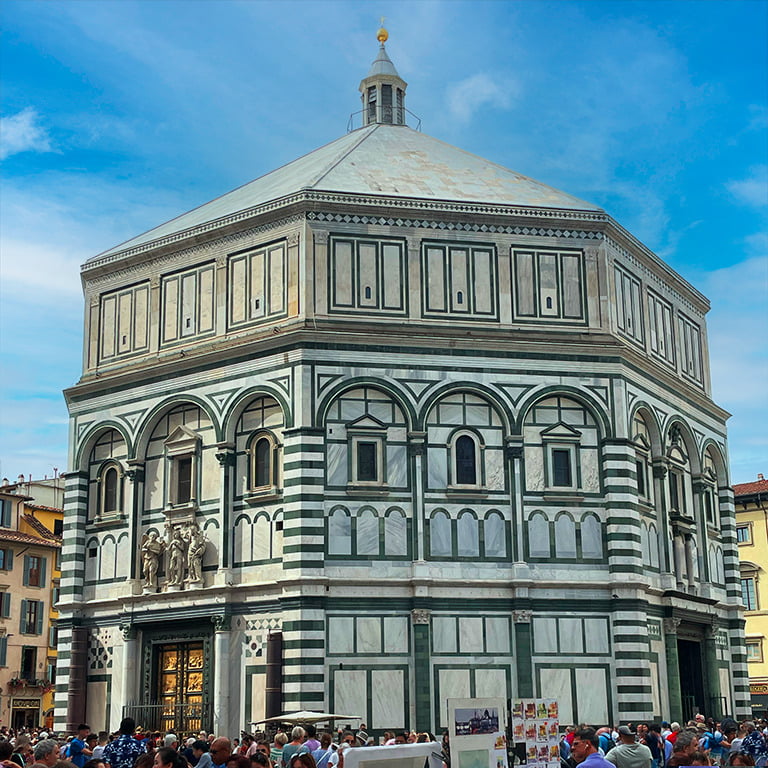
Giotto Tower
Giotto’s Tower is an impressive bell tower located next to the Cathedral of Santa Maria del Fiore. This majestic structure is dedicated to the architect and artist Giotto di Bondone, and is one of the icons of Italian Gothic and Renaissance architecture.
Construction of Giotto’s Tower began in 1334 under Giotto’s supervision, but was completed by other architects after his death in 1337. The building is known for its slender structure and rich decorations in white, pink and green marble, which include sculptures, reliefs and geometrically shaped windows. The tower is approximately 84 metres high and offers an extraordinary panoramic view of the city of Florence and its surroundings. One of the most fascinating features of Giotto’s Tower is the series of decorated panels depicting stories and scenes from the Bible, created by various Renaissance artists, including Andrea Pisano and Luca della Robbia. These panels run along the façade and offer an extraordinary visual experience.
Climbing the 414 steps to the top of Giotto’s Tower is an unforgettable experience. Once at the top, visitors are rewarded with a breathtaking view of the city of Florence, with the Duomo of Santa Maria del Fiore standing majestically beside it.
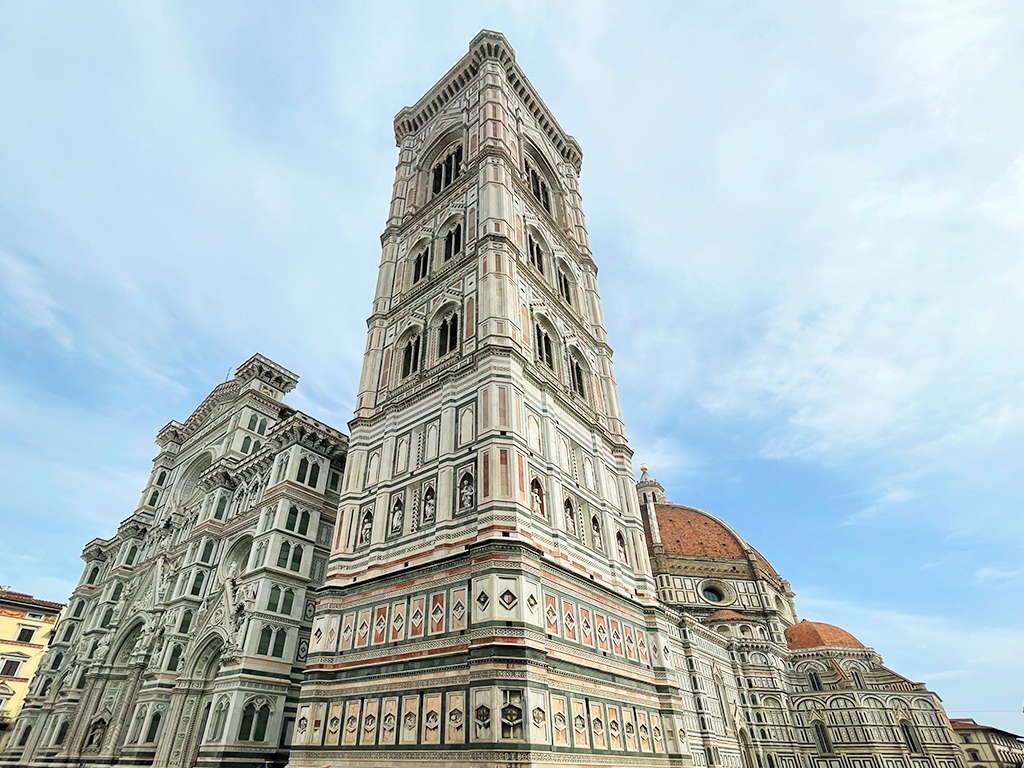
Piazza della Signoria
Piazza della Signoria is the beating heart of Florence, a square that embodies the history, art and culture of this extraordinary city.
In the centre of the square stands the equestrian statue of Cosimo I de’ Medici, one of the most influential members of the Medici family that ruled Florence for centuries. This majestic statue is surrounded by a series of sculptures and fountains, including the famous Fountain of Neptune and a copy of Michelangelo’s David.
One of the most impressive buildings overlooking the square is Palazzo Vecchio, a true icon of the city. This medieval palace was the residence of the Medici and the centre of city government during the Renaissance. Today, it houses the Museo Civico di Firenze and the Salone dei Cinquecento, an artistic masterpiece with frescoes by Giorgio Vasari. Another fascinating feature of this square is the Loggia dei Lanzi, an open-air gallery housing a valuable collection of Renaissance sculptures, including the now iconic Perseus with the Head of Medusa by Benvenuto Cellini and the Rape of the Sabine Women by Giambologna.
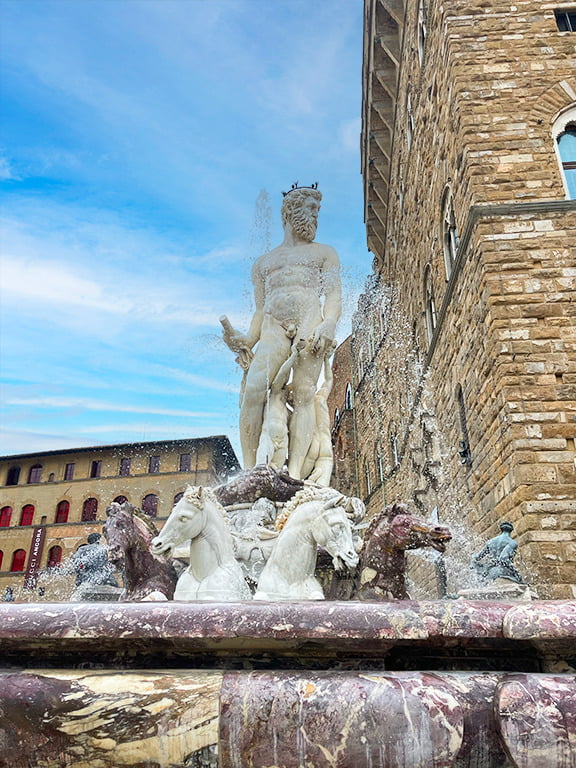
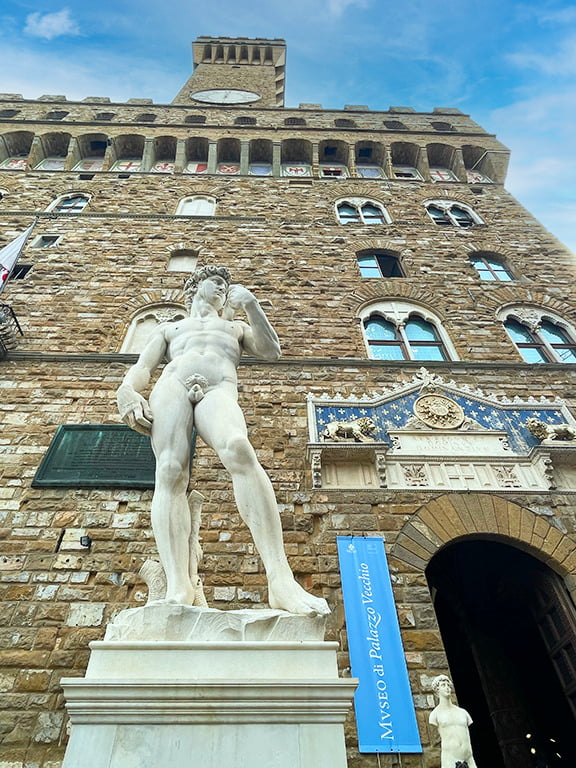
Old Bridge
The Ponte Vecchio in Florence is one of the most iconic and fascinating bridges in the world, steeped in history, beauty and romance. Located on the Arno River, this bridge is one of the city’s most emblematic attractions with a panoramic view of the river and the picturesque medieval houses that line its banks. But what really makes the Ponte Vecchio special are its workshops of jewellers, goldsmiths and art sellers.
This bridge has been a meeting and trading place for Florentines since the 14th century, and today continues to be a centre of artistic and commercial activity. During the Renaissance, the bridge housed a series of butcher shops, but in 1593 Grand Duke Ferdinando I de’ Medici decided to replace the meat shops with those of the goldsmiths, establishing a tradition that continues to this day. Today, the shops on the bridge display fine jewellery, watches, works of art and handmade souvenirs representing traditional Florentine craftsmanship.
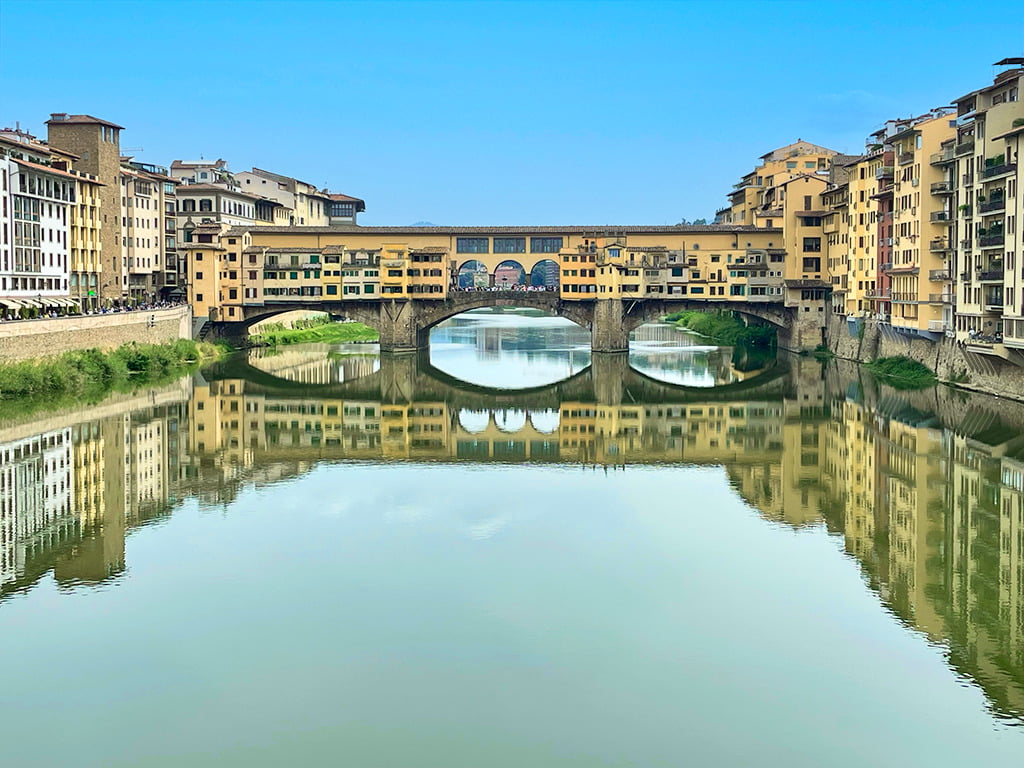
A tasteful stop: The Central Market in Florence
Also known as the San Lorenzo Market, it is an unmissable stop for those who want to savour traditional Tuscan flavours.
The imposing structure that houses it, made of iron, cast iron and glass, was built in the 19th century to a design by Giuseppe Mengoni – the creator of the Galleria Vittorio Emanuele II in Milan – and has recently been renovated, giving it new life. On the ground floor is the market with stalls selling fruit, vegetables, meat and fish. The first floor is dedicated to street food, the market brings together shops and restaurants offering local, national and international specialities, ‘from Lampredotto accompanied by a glass of Chianti to fried fish, from Chinese ravioli to French pastries’. The streets outside, on the other hand, are always crowded with the stalls of artisans and souvenir sellers.
The most beautiful panorama: Piazzale Michelangelo
Piazzale Michelangelo – located at the end of a beautiful tree-lined avenue called Viale dei Colli – was designed and built in 1869 by architect Giuseppe Poggi and was dedicated to the famous Renaissance artist and adorned with bronze copies of some of his works, including the famous David that dominates the centre of the square.
It is called the ‘Terrace of Florence‘ because it offers the most extraordinary view of the city and all its majestic monuments: the course of the Arno and its bridges, the Basilica of Santa Croce and Brunelleschi’s dome, Palazzo Vecchio and its tower. The best time is sunset, the city takes on a magical light and the spectacle is assured.
TipsforTrips: Piazzale Michelangelo can be reached on foot by taking the steps from San Niccolò, it takes about 30 minutes. It is also possible to reach the square by car, it is very easy to find free parking in the areas surrounding the square. A good alternative is to use the bus: bus no. 12 or 13 from Santa Maria Novella station takes about 20 minutes (without traffic).
Museums not to be missed
Uffizi Gallery
The Uffizi Museum in Florence is an essential stop for any art and culture enthusiast visiting Florence.
Inside, one is immersed in a world of timeless works of art by Italian Renaissance masters such as Leonardo da Vinci, Michelangelo, Botticelli and Raphael. The rooms of the museum are like a journey through the centuries, an experience that allows you to follow the evolution of Italian art from its inception in the Middle Ages to the height of the Renaissance. Classical sculptures, sacred paintings, decorative works of art and ceiling frescoes contribute to the extraordinary atmosphere. The highlight of a visit to the Uffizi is an encounter with Botticelli’s Birth of Venus and Primavera.
Academy Gallery
The Accademia Gallery, located in the heart of Florence, is best known for being the home of one of the world’s most famous sculptures: Michelangelo’s David. As soon as you walk through the doors of the Accademia, you will be greeted by the majesty and elegance of the David, which towers in the centre of the museum. This iconic work of art enchants visitors with its extraordinary beauty, perfect proportions and unparalleled skill of the artist. Admiring this sculpture in all its splendour is an experience that touches the heart and soul of anyone who approaches it.
In addition to the David, you can discover other works by Michelangelo, including the statues of the Slaves and the Palestrina Pietà. In addition, the Accademia houses a vast collection of paintings, sculptures and historical artefacts, allowing you to immerse yourself even further in the rich artistic history of Florence and Italy. A distinctive feature of the Accademia Museum is its intimate atmosphere: the relatively small size of the museum makes it an ideal place to quietly explore the artworks without the crowds often found in other famous museums.
Pitti Palace
The Pitti Palace is a jewel that represents the magnificence and prestige of the city. Located on the left bank of the Arno River, it was built in the 15th century for the Pitti family but has been the home of various powerful rulers and nobles over the centuries, including the Medici, who have left an indelible mark on the city. Today it is a vast museum complex housing various art galleries, museums and historical treasures.
One of the most famous attractions inside the palace is the Palatine Gallery, which features an extraordinary collection of paintings by Renaissance artists such as Raphael, Titian, and Rubens. The palace’s sumptuous rooms and original furnishings provide an extraordinary backdrop for these works of art. The Pitti Palace is also home to the Silver Museums, which include a vast collection of jewellery, silverware, and precious ornaments that belonged to members of the Medici royal family. Here, you can admire splendid crowns, ornate swords and sumptuous period clothing. Within its magnificent gardens, known as the Boboli Gardens, visitors can stroll among fountains, statues and groves, enjoying spectacular panoramic views over the city of Florence.
Last modified: 15 June 2025
